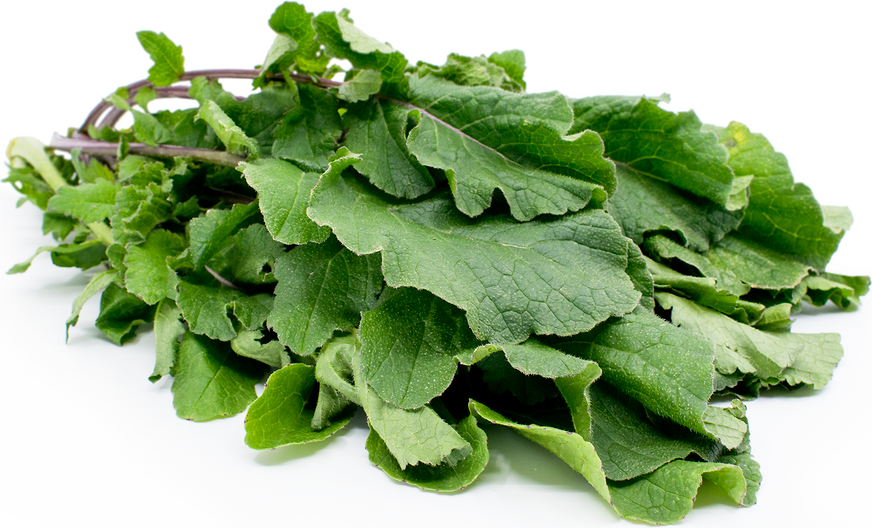


Wild Mustard
Estimated Inventory, lb : 0
Description/Taste
Wild Mustard is an indigenous plant that can grow anywhere from 40 to 100 centimeters tall. Its elongated stalks have rounded, lobed leaves with stiff, sparse hairs along the stem. The leaves begin as rosettes at the bottom and thin out, clinging more to the stem as they go up. The plant is grassy green with a purple stem, similar to an eggplant's color. With finely toothed margins, the leaves have a slightly coarse and rough texture. Wild Mustard has bright yellow flowers with four cross-shaped petals and six stamens, four long and two short, that are crucial for making pollen. As new flowers bloom at the top, the lower ones transition into elongated, four-sided seedpods, encasing small, dark brown seeds. Wild Mustard releases a distinctive, sharp aroma with a spicy, earthy, and peppery quality, particularly noticeable when the leaves or stems are crushed. This scent is reminiscent of horseradish, mirroring the plant's flavors. As it matures, the leaves develop a more pronounced peppery taste, while the flowers offer a unique blend of honey and horseradish flavors.
Seasons/Availability
Wild Mustard is an annual herb that’s best harvested in early spring.
Current Facts
Wild Mustard plants belong to the Brassicaceae family, sharing lineage with vegetables like cabbage, cauliflower, broccoli, turnips, kale, and kohlrabi. There are roughly ten species of Wild Mustard, including Brassica rapa and Brassica nigra, which are commonly known as field mustard and black mustard. Wild Mustard can be pressed to extract oil, which is used as a tonic in ways similar to castor oil. It’s valued as "green manure" for its ability to enrich the soil with nitrogen. Consuming mustard plants can potentially boosting your appetite, aid in digestion, and act as a natural decongestant.
Nutritional Value
Wild Mustard shares health benefits with other cruciferous vegetables, being nutrient-dense and low in calories. It's rich in vitamins A, C, K, E, and folic acid. Its vitamin A enhances skin and vision health while its folic acid combats homocysteine, potentially lowering the risk of heart disease. Wild Mustard is a good source of dietary fiber and minerals such as calcium, iron, magnesium, potassium, zinc, selenium, and manganese. The nutritional content of Wild Mustard greens is linked with reduced risks of conditions such as arthritis, osteoporosis, iron-deficiency anemia, and respiratory diseases like asthma.
Applications
Every part of the Wild Mustard plant, including its leaves, seeds, and stems, is edible at any growth stage. The greens can be cooked similarly to spinach and broccoli rabe, infusing dishes with a peppery zest. A quick sauté with olive oil and garlic transforms them into a flavorful side dish, while more mature Wild Mustard greens can be stewed or braised with ham or smoked meats for depth. When the stems are finely chopped, they can be used for sautéing, adding crunch to salads, or even juicing. Their seeds can be pickled, dried, crushed, or blended with vinegar and other seasonings to create piquant condiments, spice up Indian dishes, or to produce mustard oil. The sweet and spicy undertones of Wild Mustard flowers make them a suitable garnish for salads. Wild Mustard greens pair well with garlic, salt, pepper, thyme, rosemary, lemon, honey, maple syrup, fruits like apples, pears, and oranges, nuts, and cheeses such as Parmesan, goat cheese, feta, and sharp cheddar. They also complement legumes, bacon, sausage, grilled chicken, and beef. To keep Wild Mustard fresh, store it in a plastic bag in the refrigerator for up to a week.
Ethnic/Cultural Info
Wild Mustard has evolved into various domestic mustards that are used in many different cultures. France is renowned for producing Dijon mustard, which originates from the region of Dijon in Burgundy. Brown mustard seeds are used to make some of the hotter varieties, including those used in Chinese mustards. Black mustard seeds are common in Indian and West Indian cooking, where they are often fried in oil until they pop, releasing a spicy flavor that is a hallmark of many dishes in these cuisines. Wild Mustard and other foraged greens have been incorporated into African American culinary traditions, especially in the context of survival and resourcefulness during periods of slavery and beyond.
Geography/History
Wild Mustard has native populations in Asia, Europe, and North Africa and has become invasive across North America, particularly noticeable in Southern California. This plant is among the earliest domesticated crops, with evidence of its cultivation stretching back to ancient times. The tradition of making a paste from crushed mustard seeds and unfermented grape juice started around 1300, a technique later adopted by the Romans. Canada stands out as a leading producer of mustard seeds, especially white or yellow mustard seeds used for condiments. Wild Mustard is commonly found in roadsides, fields, pastures, orchards, vineyards, urban areas, and farmlands, often outcompeting native species. It adapts well to various garden settings, requiring full sunlight and moderate watering. The spread of Wild Mustard in California traces back to Spanish missionaries. While not typically available in grocery stores, Wild Mustard can be foraged or grown in home gardens, with farmers markets being a prime spot to find it, particularly in regions that value local, foraged, and native plants.
Recipe Ideas
Recipes that include Wild Mustard. One
| Honest Food dot Net |
|
Basic Country Mustard |
| French Foodie Baby |
|
Asparagus, Arugula, Avocado Soup with Wild Mustard Flowers |
| Ciao Chow Linda |
|
Spaghetti With Winter Cress (Mustard Greens) |




